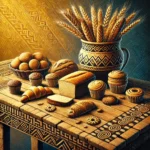I. Introduction to Kenyan Cuisine and Bread Culture
A. Overview of traditional Kenyan staples
Kenyan cuisine is characterized by a rich tapestry of flavors and textures, deeply rooted in the country’s diverse cultural heritage. Traditional staples include maize-based dishes, such as ugali, alongside an array of vegetables, legumes, and occasionally meat or fish. These foods have sustained generations and continue to play a central role in Kenyan dining.
B. The role of bread in modern Kenyan dining
In recent years, bread has gained prominence in Kenyan households, particularly in urban areas. This shift reflects changing dietary habits and Western influences on local food culture. Bread now serves as a convenient alternative to traditional starches, often accompanying morning tea or as a base for quick meals.
C. Importance of cultural fusion in food pairings
The integration of bread with traditional Kenyan dishes represents a fascinating culinary evolution. This fusion not only enhances the dining experience but also reflects Kenya’s openness to global influences while maintaining its culinary identity. The art of pairing bread with Kenyan dishes offers an opportunity to bridge cultures and create new gastronomic experiences.
II. Understanding Ugali and Sukuma Wiki
A. What is Ugali: Ingredients and preparation
Ugali, a staple in Kenyan cuisine, is a firm, dough-like dish made primarily from maize flour. Its preparation involves adding the flour to boiling water and stirring vigorously until it reaches a thick, smooth consistency. The result is a dense, starchy accompaniment that serves as the foundation for many Kenyan meals.
B. Sukuma Wiki: The quintessential Kenyan side dish
Sukuma Wiki, which translates to “stretch the week” in Swahili, is a nutritious vegetable dish made from collard greens or kale. These leafy greens are typically sautéed with onions, tomatoes, and minimal spices, creating a flavorful and economical side dish that complements the neutral taste of ugali.
C. Traditional serving methods and cultural significance
Traditionally, ugali and Sukuma Wiki are served together on a single plate. Diners use their right hand to pinch off a portion of ugali, shape it into a small ball, and create an indentation to scoop up the Sukuma Wiki. This method of eating symbolizes communal dining and the importance of sharing meals in Kenyan culture.
III. Types of Bread Suitable for Kenyan Pairings
A. Artisan loaves: Sourdough and whole grain options
Artisan breads, with their complex flavors and textures, offer interesting pairing possibilities with Kenyan dishes. Sourdough, with its slight tanginess, can complement the earthy flavors of Sukuma Wiki. Whole grain breads provide a nutty taste and additional nutritional benefits, aligning well with the wholesome nature of traditional Kenyan fare.
B. Flatbreads: Naan, chapati, and injera
Flatbreads, already popular in East African cuisine, serve as excellent accompaniments to Kenyan dishes. Chapati, a common bread in Kenya, pairs naturally with Sukuma Wiki. Naan and injera, though not traditionally Kenyan, offer interesting textures and flavors that can enhance the dining experience when combined with local dishes.
C. Enriched breads: Brioche and milk bread
Enriched breads like brioche and milk bread, with their soft texture and slightly sweet flavor, present an intriguing contrast to the robust flavors of Kenyan cuisine. These breads can be particularly appealing when paired with milder variations of Sukuma Wiki or used to create fusion dishes.
IV. Pairing Principles: Bread Meets Kenyan Flavors
A. Complementing textures: Soft bread with firm Ugali
When pairing bread with ugali, consider textural contrasts. The softness of bread can provide a pleasing counterpoint to the firm texture of ugali. For instance, a slice of soft artisan bread can be used to scoop up a mixture of crumbled ugali and Sukuma Wiki, creating a harmonious blend of textures in each bite.
B. Balancing flavors: Mild bread with spicy Sukuma Wiki
The key to successful flavor pairing lies in balance. Mild-flavored breads, such as white sandwich bread or milk bread, can serve as a neutral backdrop for the more assertive flavors of spicy Sukuma Wiki variations. Conversely, breads with stronger flavors, like sourdough, may pair better with milder versions of the dish.
C. Considering moisture levels in dishes and bread
The moisture content of both the bread and the Kenyan dishes should be taken into account when pairing. Drier breads, such as toasted sourdough, can benefit from the moisture in Sukuma Wiki. Conversely, softer, more absorbent breads can help to soak up the flavorful juices of saucier Kenyan dishes.
V. Innovative Pairing Ideas
A. Ugali-stuffed bread rolls
An innovative approach to combining ugali and bread is to create ugali-stuffed bread rolls. This fusion dish involves encasing seasoned, cooled ugali within bread dough before baking. The result is a unique handheld meal that showcases both Kenyan and Western culinary elements.
B. Sukuma Wiki bruschetta on artisan toast
Transforming Sukuma Wiki into a topping for bruschetta offers a creative way to pair it with artisanal bread. Finely chopped and seasoned Sukuma Wiki can be spooned onto toasted slices of sourdough or whole grain bread, creating an appetizer that bridges Kenyan and Italian cuisines.
C. Kenyan-inspired bread pudding with local fruits
A dessert option that incorporates bread into a Kenyan-inspired dish is a bread pudding made with local fruits. Using day-old bread soaked in a custard infused with Kenyan flavors like cardamom or ginger, and studded with tropical fruits such as mango or passion fruit, creates a sweet ending to a fusion meal.
VI. Nutritional Considerations
A. Balancing carbohydrates: Ugali and bread together
When pairing ugali and bread, it’s important to be mindful of the overall carbohydrate content of the meal. Both are starch-heavy foods, so consider reducing the portion sizes of each to maintain a balanced diet. Alternatively, opt for whole grain breads to increase the fiber content and nutritional value of the meal.
B. Increasing fiber intake with whole grain breads
Incorporating whole grain breads into meals that traditionally feature ugali can boost the fiber content of the diet. This not only aids in digestion but also provides a more sustained release of energy, which can be beneficial for overall health and satiety.
C. Protein complementation: Combining legumes with bread
To create a more nutritionally complete meal, consider adding legume-based dishes to the bread and Sukuma Wiki pairing. Beans or lentils, which are common in Kenyan cuisine, can provide essential amino acids that complement the proteins found in bread and vegetables, resulting in a well-rounded, protein-rich meal.
Summary
The fusion of traditional Kenyan dishes with various types of bread opens up a world of culinary possibilities. By understanding the characteristics of ugali and Sukuma Wiki, and applying thoughtful pairing principles, one can create meals that honor Kenyan culinary traditions while embracing global influences. This approach not only enhances the dining experience but also offers nutritional benefits when executed mindfully. As Kenyan cuisine continues to evolve, the integration of bread with traditional dishes serves as a testament to the dynamic nature of food culture.
FAQs
1. Can I substitute Ugali with bread in traditional Kenyan meals?
While bread can be used as an alternative starch in Kenyan meals, it’s important to note that it will significantly alter the traditional experience. Ugali has a unique texture and neutral flavor that plays a specific role in Kenyan cuisine. Bread can be incorporated alongside ugali or as an occasional substitute, but it may not fully replicate the cultural and gastronomic experience of a traditional Kenyan meal.
2. What are the best breads to pair with spicy Kenyan dishes?
For spicy Kenyan dishes, consider pairing them with breads that have a mild flavor and absorbent texture. Naan, milk bread, or plain white bread can help balance the heat and soak up flavorful sauces. Whole wheat or multigrain breads can also work well, offering a nutty flavor that complements spicy dishes while providing additional nutritional benefits.
3.How can I incorporate Kenyan flavors into homemade bread?
To infuse Kenyan flavors into homemade bread, consider adding spices commonly used in Kenyan cuisine, such as cardamom, coriander, or cumin, to your bread dough. You could also incorporate dried fruits like dates or raisins, which are popular in Kenyan sweets. Another option is to create a savory bread by adding finely chopped Sukuma Wiki or other Kenyan vegetables to the dough before baking.











